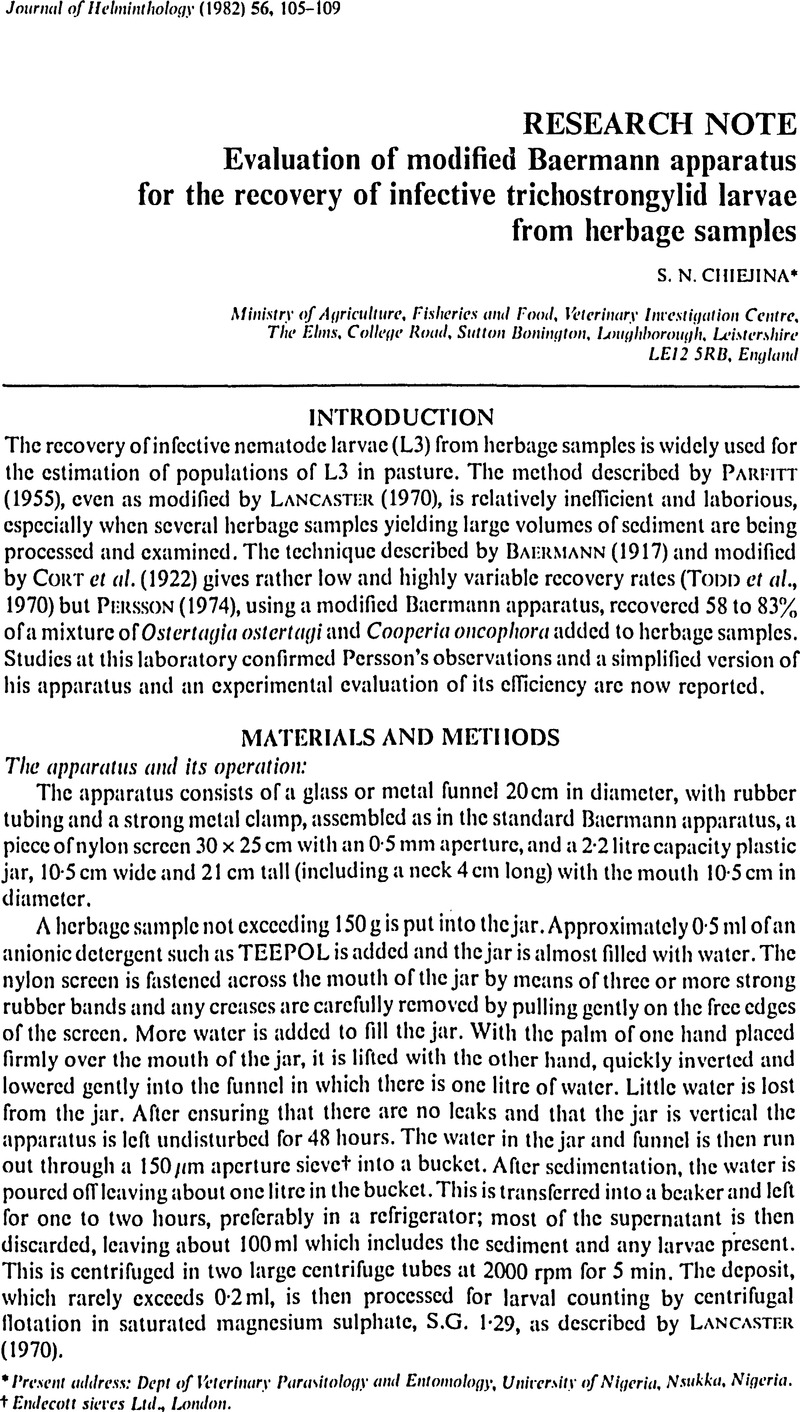Crossref Citations
This article has been cited by the following publications. This list is generated based on data provided by Crossref.
Herd, R.P.
1984.
Potential problems associated with the controlled release of anthelmintics in grazing animals.
Veterinary Parasitology,
Vol. 16,
Issue. 3-4,
p.
325.
Chiejina, S.N.
and
Fakae, B.B.
1984.
Development and survival of infective larvae of gastrointestinal nematode parasites of cattle on pasture in eastern Nigeria.
Research in Veterinary Science,
Vol. 37,
Issue. 2,
p.
148.
Chiejina, S.N.
and
Emehelu, C.O.
1984.
Seasonal changes in pasture populations of infective larvae of gastrointestinal nematodes of cattle in eastern Nigeria.
Research in Veterinary Science,
Vol. 37,
Issue. 2,
p.
144.
Chiejina, S. N.
and
Emehelu, C. O.
1986.
Evaluation of three strategic anthelmintic programmes for the prophylaxis of parasitic gastroenteritis in cattle in Nigeria.
Tropical Animal Health and Production,
Vol. 18,
Issue. 1,
p.
55.
Cabaret, J.
Mangeon, N.
and
Gruner, L.
1986.
Estimation of uptake of digestive tract strongyle larvae from pasture, using oesophagus fistulated sheep.
Veterinary Parasitology,
Vol. 19,
Issue. 3-4,
p.
315.
Chiejina, S.N.
1987.
Some parasitic diseases of intensively managed West African Dwarf sheep and goats in Nsukka, eastern Nigeria.
British Veterinary Journal,
Vol. 143,
Issue. 3,
p.
264.
Chiejina, S. N.
and
Fakae, B. B.
1989.
The ecology of infective larvae of bovine gastrointestinal trichostrongylids in dry season contaminated pastures in the Nigerian derived savanna.
Journal of Helminthology,
Vol. 63,
Issue. 2,
p.
127.
Chiejina, S. N.
Fakae, B. B.
and
Eze, P. I.
1989.
Development and survival of free-living stages of gastrointestinal nematodes of sheep and goats on pasture in the Nigerian derived savanna.
Veterinary Research Communications,
Vol. 13,
Issue. 2,
p.
103.
Rahman, Wahab A.
and
Collins, G. H.
1990.
Seasonal variations in the populations of infective larvae on pasture and the numbers of nematode eggs in the faeces of farmed goats.
Journal of Helminthology,
Vol. 64,
Issue. 3,
p.
263.
Martin, R.R.
Beveridge, I.
Pullman, A.L.
and
Brown, T.H.
1990.
A modified technique for the estimation of the number of infective nematode larvae present on pasture, and its application in the field under South Australian conditions.
Veterinary Parasitology,
Vol. 37,
Issue. 2,
p.
133.
Couvillion, C.E.
1993.
Estimation of the numbers of trichostrongylid larvae on pastures.
Veterinary Parasitology,
Vol. 46,
Issue. 1-4,
p.
197.
Fine, A.E.
Hartman, R.
Krecek, R.C.
and
Groeneveld, H.T.
1993.
Effects of time, from collection to processing, on the recovery of Haemonchus contortus third-stage larvae from herbage.
Veterinary Parasitology,
Vol. 51,
Issue. 1-2,
p.
77.
Aumont, G.
Frauli, D.
Simon, R.
Pouillot, R.
Diaw, S.
and
Mandonnet, N.
1996.
Comparison of methods for counting third stage larvae of gastrointestinal nematodes of small ruminants in tropical pastures.
Veterinary Parasitology,
Vol. 62,
Issue. 3-4,
p.
307.
Cheah, T. S.
and
Rajamanickam, C.
1997.
Epidemiology of gastro-intestinal nematodes of sheep in wet tropical conditions in Malaysia.
Tropical Animal Health and Production,
Vol. 29,
Issue. 3,
p.
165.
Demeler, Janina
Knapp, Friederike
Corte, Giuliano Mario
Katzschke, Oliver
Steininger, Katharina
and
von Samson-Himmelstjerna, Georg
2012.
Recovery of strongylid third-stage larvae from herbage samples: standardisation of a laboratory method and its application in the field.
Parasitology Research,
Vol. 110,
Issue. 3,
p.
1159.



